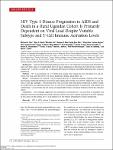| dc.contributor.author | Eller, Michael A. | |
| dc.contributor.author | Opollo, Marc S. | |
| dc.contributor.author | Liu, Michelle | |
| dc.contributor.author | Redd, Andrew D. | |
| dc.contributor.author | Leigh, Anne Eller | |
| dc.contributor.author | Kityo, Cissy | |
| dc.contributor.author | Kayiwa, Joshua | |
| dc.contributor.author | Laeyendecker, Oliver | |
| dc.contributor.author | Wawer, Maria J. | |
| dc.contributor.author | Milazzo, Mark | |
| dc.contributor.author | Kiwanuka, Noah | |
| dc.contributor.author | Gray, Ronald H. | |
| dc.contributor.author | Serwadda, David | |
| dc.contributor.author | Sewankambo, Nelson K. | |
| dc.contributor.author | Quinn, Thomas C. | |
| dc.contributor.author | Michael, Nelson L. | |
| dc.contributor.author | Wabwire-Mangen, Fred | |
| dc.contributor.author | Sandberg, Johan K. | |
| dc.contributor.author | Robb, Merlin L. | |
| dc.date.accessioned | 2023-07-17T14:02:23Z | |
| dc.date.available | 2023-07-17T14:02:23Z | |
| dc.date.issued | 2015 | |
| dc.identifier.citation | Eller, M. A., Opollo, M. S., Liu, M., Redd, A. D., Eller, L. A., Kityo, C., ... & Robb, M. L. (2015). HIV type 1 disease progression to AIDS and death in a rural Ugandan cohort is primarily dependent on viral load despite variable subtype and T-cell immune activation levels. The Journal of infectious diseases, 211(10), 1574-1584. | en_US |
| dc.identifier.uri | DOI: 10.1093/infdis/jiu646 | |
| dc.identifier.uri | http://ir.lirauni.ac.ug/xmlui/handle/123456789/735 | |
| dc.description.abstract | Background. Untreated human immunodeficiency virus type 1 (HIV) infection is associated with persistent im mune activation, which is an independent driver of disease progression in European and United States cohorts. In
Uganda, HIV-1 subtypes A and D and recombinant AD viruses predominate and exhibit differential rates of disease
progression.
Methods. HIV-1 seroconverters (n = 156) from rural Uganda were evaluated to assess the effects of T-cell acti vation, viral load, and viral subtype on disease progression during clinical follow-up.
Results. The frequency of activated T cells was increased in HIV-1–infected Ugandans, compared with commu nity matched uninfected individuals, but did not differ significantly between viral subtypes. Higher HIV-1 load, sub type D, older age, and high T-cell activation levels were associated with faster disease progression to AIDS or death.
In a multivariate Cox regression analysis, HIV-1 load was the strongest predictor of progression, with subtype also
contributing. T-cell activation did not emerge an independent predictor of disease progression from this particular
cohort.
Conclusions. These findings suggest that the independent contribution of T-cell activation on morbidity and
mortality observed in European and North American cohorts may not be directly translated to the HIV epidemic
in East Africa. In this setting, HIV-1 load appears to be the primary determinant of disease progression.
Keywords. HIV-1; AIDS; subtype D; immune activation; PD-1; viral load. | en_US |
| dc.language.iso | en | en_US |
| dc.publisher | The Journal of infectious diseases | en_US |
| dc.subject | HIV-1 | en_US |
| dc.subject | AIDS | en_US |
| dc.subject | subtype D | en_US |
| dc.subject | immune activation | en_US |
| dc.subject | PD-1 | en_US |
| dc.subject | viral load. | en_US |
| dc.title | HIV Type 1 Disease Progression to AIDS and Death in a Rural Ugandan Cohort Is Primarily Dependent on Viral Load Despite Variable Subtype and T-Cell Immune Activation Levels | en_US |
| dc.type | Article | en_US |

